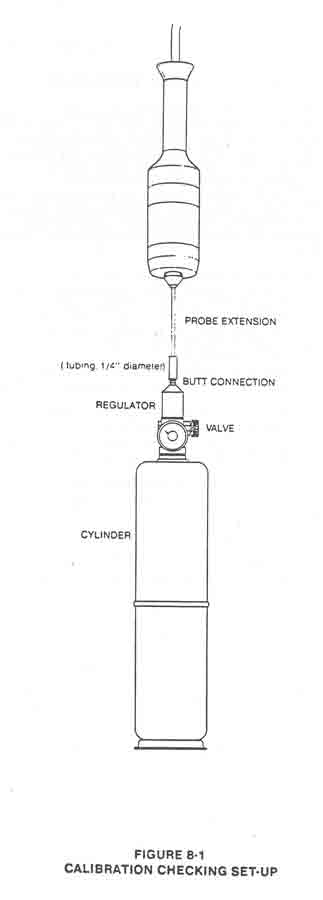Calibration with an Alternate Gas

If a calibration standard with the same trace gas as that to be measured is not available or is hazardous, it is possible to use an alternate calibration gas. (note: this techniquemay not be as accurate as calibration with the species of interest.)
In this case, the expected reading for the calibration must be compensated for the difference between the two gases. In operation, the meter will then give a direct reading of the gas being measured.
This calibration is illustrated in the following examples:
(PS = Photoionization Sensitivity. See IP Chart)
A. Given a case in which:
- The trace gas to be measured is Vinyl Chloride (PS = 3.2)
- The calibration gas used is Isobutylene (PS = 5.5) at 100 ppm
What will the ppm reading be when calibrating to give a direct reading for Vinyl Chloride?
The required reading for calibration will be:
= Isobutylene ppm * [ PS (Isobutylene) / PS (Vinyl Chloride) ]
= 100 * ( 5.5 / 3.2 )
= 172 ppm
In this example, using a calibration gas with 100 ppm of Isobutylene, adjust the SPAN control so the meter reads 172 ppm. In operation, the instrument will then give a direct reading of 100 ppm of Vinyl Chloride.
An alternate approach is to leave the instrument calibrated for isobutylene and multiply the readings by 5.5 over 3.2 = 1.72
B. Given a case in which:
- The trace gas to be measured is Benzene (PS = 10.0)
- The calibration gas to be measured is Isobutylene (PS = 5.5) at 100 ppm
What will the ppm reading be when calibrating to give a direct reading when measuring benzene?
The required reading for calibration will be:
= Isobutylene ppm *[ PS (Isobutylene) / PS (Benzene) ]
= 100 * ( 5.5 / 10.0)
= 55 ppm
In this example, using a calibration gas with 100 ppm of Isobutylene, adjust the SPAN control so the meter reads 55 ppm. In operation, the instrument will then give a direct reading of the ppm of Benzene.
C. Given a case in which:
- The trace gas to be measured is Hydrogen Sulfide (PS = 2.8)
- The level of Hydrogen Sulfide which is to be calibrated is 60 ppm.
- The calibration gas available is Isobutylene (PS = 5.5)
What concentration of Isobutylene is required to permit direct reading of hydrogen sulfide, at 60 ppm.
The required Isobutylene level for calibration will be:
= H2S ppm * [ PS (H2S) / PS (Isobutylene) ]
= 60 * (2.8 / 5.5)
= 30.5 ppm
In this example, using a calibration gas with 30.5 ppm of Isobutylene, adjust the SPAN control so the meter reads 60 ppm. In operation, the instrument will then give a direct reading of the ppm of Hydrogen Sulfide.
It is extremely important to stay below the Lower Explosive Limit (LEL) when working with flammable gas samples and with hazardous or toxic gases to stay below the Threshold Limit Value (TLV) safe working level.
If you are having difficulties when calibrating your instrument, the user should consult PID Analyzers' service department at christine@hnu.com.




